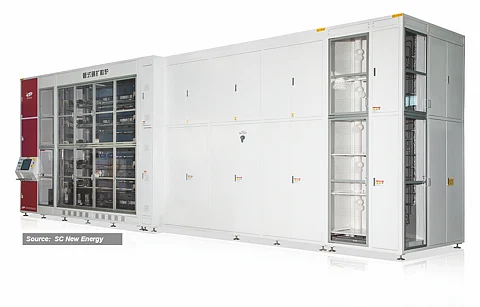

The diffusion furnaces listed in TaiyangNews Cell Production Survey 2023– a total of 14 from 7 companies – are all based on low pressure diffusion. Following the alphabetical order, Centrotherm has provided data for 2 diffusion furnaces, called c.Diff X-POCl and c.Diff X-BCl3, with the suffixes indicating their application. The latest one among the duo, the c.Diff X-BCl3, is used for boron diffusion as part of TOPCon processing, while c.Diff X-POCl is designed for phosphorus diffusion. Both the tools are offered in a 10-stack tube configuration and each tube comes with a 2,000-mm flat zone with a diameter of 350 mm. c.Diff X-BCl3 has a maximum throughput of 7,800 wafers per hour, while c.Diff X-POCI can process 11,100 wafers per hour.
Ideal Deposition from China, well known for its ALD tools, also has a diffusion furnace on offer in a 5-stack configuration called i-Diffusion. The tool is promoted for all thermal processes including boron diffusion, phosphorus diffusion, oxidation and annealing. Precise temperature control and a 595- mm inner tube diameter are the tool's most important features highlighted by the company. The multi-gas flow distribution and control helps the tool reach a sheet resistance distribution of 4%. The tool has a 2,400-mm flat zone and the boat loading capacity varies with wafer size – 2,800 G12 wafers and 3,200 M10 wafers. The system supports a rated throughput of 9,333 G12-size wafers per hour, while the tube diameter of 595 mm already supports processing wafer sizes of up to 230 mm side length.
Laplace has also provided data for a single system called LRP/LRB/LOX/LAN that is promoted for all applications such as phosphorus and boron diffusion. The system is equipped with 6 tubes that can be opted with either 430- or 480-mm diameter. The specialty of this tool is that it processes the wafer in a horizontal orientation, like Semco. The system can accommodate 2,000 to 2,400 wafers per boat. The maximum and average throughputs are given as 4,500 and 4,300 wafers per hour, respectively.
Leadmicro is another diffusion furnace supplier that has provided data for a single model. Its XH10000P is a 2023 model that is also promoted for all thermal process related applications such as POCI diffusion, boron diffusion, oxidation, and annealing. The system, integrated with 6 tubes, can process either 6,060 of M10 or 5,300 of G12 wafers per hour. It is rated with a mechanical yield of 98%.
Naura claims to have developed the first lowpressure diffusion furnace in China. We have data for 5 products from Naura. 2 are brand new products introduced in 2023, and these furnaces are not only compatible with all commercial wafer sizes, but can also be opted with 5, 6, 10 or 12 tubes depending on the desired line capacity. Of these, HORIS D12661 is a phosphorus diffusion furnace, and each tube can be loaded with 1,600 to 1,680 wafers. The HORIS D12662 is promoted for boron diffusion and, interestingly, the tool has a higher loading capacity of 2,552 to 2,880 wafers per boat. It has a 2,600-mm flat zone, 100 mm more than the above model. Both these models have a system uptime of 98% and can handle M10 and M12 wafers. The other 3 products of the company are promoted for both boron as well as phosphorus diffusion and all are offered in a 5-stack tube configuration. The main difference between these tools is the tube diameter. The HORIS D8573AL is integrated with a tube of 320 mm while the HORIS D8578AL consists of 350 mm tubes, both of which can handle wafers up to M10 size. The HORIS D12542P is equipped with 420 mm tubes that can process the G12 wafer size and beyond. These tools have a flat zone length of 1,600 mm, 2,200 mm and 2,200 mm, following the same order. The HORIS D8573AL has a throughput of 4,000 wafers per hour of up to M6, HORIS D8578AL supports 4,329 M10 cells per hour, and HORIS D12542P is rated with 4,800 of G12 wafers. S.C New Energy's solo model, DOA480L, is mainly promoted for boron diffusion in TOPCon processing. The system shell is integrated with 6 tubes each with a 480-mm diameter. The pitch of 2.72 mm facilitates loading of 2,880 of M10 wafers per tube. It has a maximum throughput of 4,850 of M10 and 3,700 G12 wafers per hour. The system uptime is given as 96% and 98% mechanical yield.
Semco has listed 3 tools in this section of the survey, one for phosphorus diffusion, one for boron diffusion, and one for oxidation and annealing. The basic characteristics of all these tools are the same, such as the ability to integrate 5 or 6 tubes, 423-mm tube diameter, 2,400-mm flat zone. As mentioned above, the specialty of these tools is that they all process wafers horizontally, and Semco was the first to introduce the concept. Each tube can accommodate 10 boats, each with a capacity of 180 wafers or a total tube capacity of 1,800 wafers. The difference is process and application. SOLUS 8000 series, designed for boron diffusion, supports a sheet resistance range of 80 to 180 ohm/sq and a throughput of 5,400 wafers per hour. The boron diffusion furnace TELLUS 8000 is rated with 7,000 wafers per hour throughput that supports a process to realize a sheet resistance range of 80 to 150 ohm/sq. DOMUS 8000, which is an oxidation and annealing system, can obviously support a higher throughput of 8,000 wafers per hour. All the systems of the company have 98% uptime and mechanical yield above 99.95%.
The article is an excerpt from the TaiyangNews Market Survey on Solar Cell Production Equipment 2023, which also includes detailed product specs and can be downloaded for free here.
